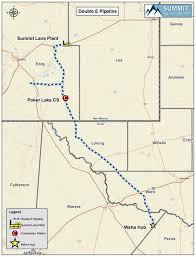
A coalition of environmental organizations challenged the federal government’s approval of a 135-mile natural gas pipeline project in Eddy County, citing regulators’ lack of analysis of the project’s impact on climate change and greenhouse gas emissions.
The Carlsbad Current Argus reported the Federal Energy Regulatory Commission (FERC) issued an environmental assessment (EA) in March, finding the proposed Double E Pipeline Project posed “minimal” environmental impact to the surrounding area, as it winds through southern Eddy County into western Texas.
The EA did report on “temporary” greenhouse gas emissions from construction and other equipment, along with some methane leaks expected, but did not reflect the cumulative impact to climate change through greenhouse gas emissions resulting from the burning of the natural gas to be transported through the line.
Rebecca Fischer, climate and energy program attorney with WildEarth Guardians said the EA was insufficient by not calculating or explaining why such downstream emissions could not be calculated.

FERC spokesperson Tamara Young-Allen said the agency does not comment on ongoing court proceedings.
“The Commission’s order in this proceeding will address all concerns raised by commenters,” she said.
WildEarth Guardians, along with the Sierra Club and Center for Biological Diversity issued a motion to intervene in the proceedings on April 23, aiming to include their concerns in the conversation as to whether the pipeline could be built.
“We think it’s important that we’re in there,” Fischer said. “There’s no environmental representation in the proceedings.”
She said FERC failed to include an analysis on the climate impact of the combustion of natural gas from the pipeline planned to have a capacity of about 1.3 billion cubic feet per day, while emitting 35.7 million metric tons of carbon dioxide (CO2) per year.
“They haven’t done any analysis on the climate impact from combustion of natural gas resources or cumulative impacts of downstream greenhouse gases,” she said. “They have to at least explain whey they can’t calculate it.”

In the EA, FERC studied numerous potential environmental impacts of the project, including effects on air quality, geology, water and wildlife.
The Assessment admitted that construction and operation of the project would impact air quality, with short-term emissions resulting from equipment use, land disturbance and increased traffic.
“Operational emissions associated with the Project would be minimal and mainly result from fugitive component leaks and other pipeline blowdown events,” read the report.
The report said Double E would mitigate such operational emissions by installing no-bleed pneumatic controllers, implementing annual leak testing, and using pump-down techniques to reduce line pressure during maintenance.
“After completion of the Project, no sources of operational emissions are anticipated other than fugitive leaks and blowdown operations,” read the report. “We conclude that construction and operation of the Project would not result in a significant impact on local or regional air quality.”
In public comments submitted to FERC by the Western Environmental Law Center, the organization argued the pipeline would have “significant” environmental impacts which FERC failed to study adequately as required by the National Environmental Policy Act.
The Center also argued that the report must explain the need for the project, as a recent decline in the value of fossil fuels, resulting from the COVID-19 pandemic and a vast reduction in fuel demands, weekend the market for the gas’ transportation.
Last week, the price per barrel of domestic crude fell below $0 per barrel for the first time in history, a sign to many that demands for fossil fuel no longer warrant added infrastructure to extract, process and transport oil and gas.
“Due to the COVID-19 pandemic, the market for the natural gas proposed to be transported by the pipeline is far from certain,” read the Center’s comments. “Oil and gas companies are going bankrupt, laying off workers, drastically cutting capital spending. The price of oil had already fallen well below break-even levels.”
Fischer questioned the EA for not including the broader, potential greenhouse gas emissions resulting from the pipeline as natural gas is transported to its destination at the Waha Hub near Pecos County in West Texas.
She said the capacity of the line posed a risk that air-polluting natural gas could be released into an area already grappling with widespread air quality problems.
Carlsbad’s level of ozone, a pollutant created when sunlight interacts with volatile organic compounds in the air, such as methane or CO2, was reported last year at 74 parts per billion (ppb), exceeding the National Ambient Air Quality Standard (NAAQS) set by the Environmental Protection Agency at 70 ppb.
Only two other communities in New Mexico were as high as Carlsbad: Desert View and Santa Teresa in Doña Ana County near the U.S.-Mexico border.
When a community is reported at 95 percent of the standard, the State of New Mexico was required by state statute to enact voluntary measures to reduce ozone levels, hoping to avoid being labeled a “non-attainment” zone by the EPA which could trigger federal air quality requirements.
FERC has recently backtracked on its focus for cumulative greenhouse gas emissions, Fischer said, as part of a broader pattern by the administration of President Donald Trump to curtail environmental protections.
“We’ve been seeing them back off of analyzing greenhouse gas emissions downstream,” she said. “Which we believe is a violation of federal law. Climate change is driven by millions of other sources, and if they all say they’re just showing a small effect, that will collectively lead to a big effect and a climate crisis.”
If the groups are granted entrance into the proceedings, Fischer said they would oppose the pipeline’s construction.
“Ultimately, we don’t think the pipeline should be built because of the environmental impacts. And with the economic changes, we don’t know if it would even be needed,” she said. “If it does go forward, we can ensure it will be a better project.”
Source: Carlsbad Current Argus





